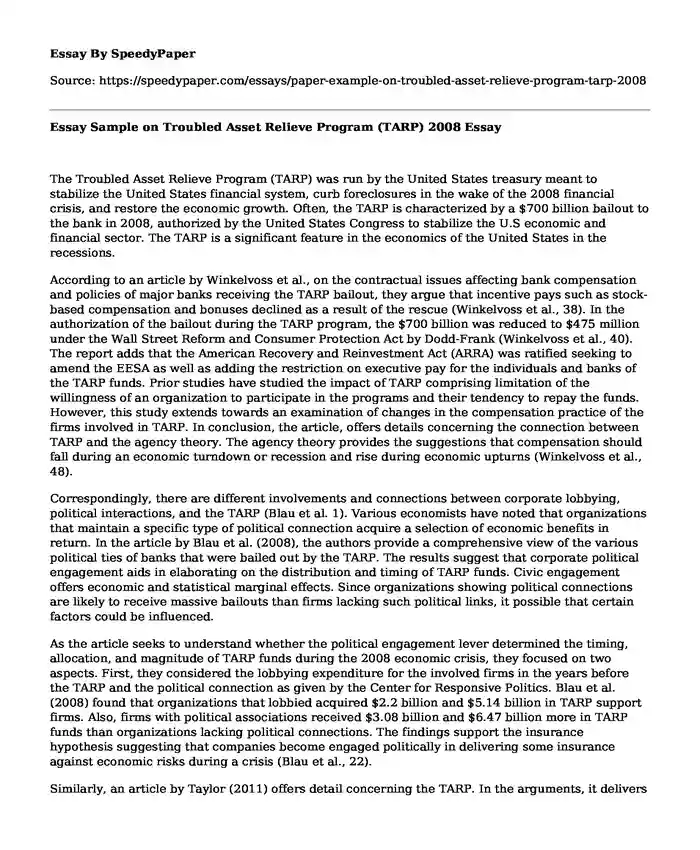The Troubled Asset Relieve Program (TARP) was run by the United States treasury meant to stabilize the United States financial system, curb foreclosures in the wake of the 2008 financial crisis, and restore the economic growth. Often, the TARP is characterized by a $700 billion bailout to the bank in 2008, authorized by the United States Congress to stabilize the U.S economic and financial sector. The TARP is a significant feature in the economics of the United States in the recessions.
According to an article by Winkelvoss et al., on the contractual issues affecting bank compensation and policies of major banks receiving the TARP bailout, they argue that incentive pays such as stock-based compensation and bonuses declined as a result of the rescue (Winkelvoss et al., 38). In the authorization of the bailout during the TARP program, the $700 billion was reduced to $475 million under the Wall Street Reform and Consumer Protection Act by Dodd-Frank (Winkelvoss et al., 40). The report adds that the American Recovery and Reinvestment Act (ARRA) was ratified seeking to amend the EESA as well as adding the restriction on executive pay for the individuals and banks of the TARP funds. Prior studies have studied the impact of TARP comprising limitation of the willingness of an organization to participate in the programs and their tendency to repay the funds. However, this study extends towards an examination of changes in the compensation practice of the firms involved in TARP. In conclusion, the article, offers details concerning the connection between TARP and the agency theory. The agency theory provides the suggestions that compensation should fall during an economic turndown or recession and rise during economic upturns (Winkelvoss et al., 48).
Correspondingly, there are different involvements and connections between corporate lobbying, political interactions, and the TARP (Blau et al. 1). Various economists have noted that organizations that maintain a specific type of political connection acquire a selection of economic benefits in return. In the article by Blau et al. (2008), the authors provide a comprehensive view of the various political ties of banks that were bailed out by the TARP. The results suggest that corporate political engagement aids in elaborating on the distribution and timing of TARP funds. Civic engagement offers economic and statistical marginal effects. Since organizations showing political connections are likely to receive massive bailouts than firms lacking such political links, it possible that certain factors could be influenced.
As the article seeks to understand whether the political engagement lever determined the timing, allocation, and magnitude of TARP funds during the 2008 economic crisis, they focused on two aspects. First, they considered the lobbying expenditure for the involved firms in the years before the TARP and the political connection as given by the Center for Responsive Politics. Blau et al. (2008) found that organizations that lobbied acquired $2.2 billion and $5.14 billion in TARP support firms. Also, firms with political associations received $3.08 billion and $6.47 billion more in TARP funds than organizations lacking political connections. The findings support the insurance hypothesis suggesting that companies become engaged politically in delivering some insurance against economic risks during a crisis (Blau et al., 22).
Similarly, an article by Taylor (2011) offers detail concerning the TARP. In the arguments, it delivers that there is no tangible evidence supporting the consideration that TARP gave a stabilizing effect on the United States economy and financial Market. Instead, the article offers that the TARP rollout might have exacerbated the United States' economic crisis. Although there are several stabilizing effects, it is critical to note that other actions could have been considered (Taylor 6).
Conclusion
In conclusion, it is evident that the TARP delivers significant effects to the economic crisis in the U.S. regardless of the different arguments offered, it is critical to note that TARP only applied an action to bail out banks. However, this does not mean the response should have helped in the economic crisis.
Works Cited
Blau, Benjamin M., Tyler Brough, and Diana Weinert Thomas. "Corporate lobbying, political connections, and the 2008 Troubled Asset Relief Program." Political Connections, and the (2008). 1-32.
Taylor, John. "Evaluating the TARP." Senate Banking Committee Written Testimony, March 17 (2011).
Winkelvoss, Clayton M., Anthony J. Amoruso, and Jonathan Duchac. "Executive Compensation at Banks Receiving Federal Assistance Under the Troubled Asset Relief Program (TARP)." Journal of Legal, Ethical & Regulatory Issues 17.2 (2014). 37-49.
Cite this page
Essay Sample on Troubled Asset Relieve Program (TARP) 2008. (2023, Mar 13). Retrieved from https://speedypaper.com/essays/paper-example-on-troubled-asset-relieve-program-tarp-2008
Request Removal
If you are the original author of this essay and no longer wish to have it published on the SpeedyPaper website, please click below to request its removal:
- Essay Example on Obesity in Teenagers
- The United States Is Not Really a Democracy - Essay Example
- Free Essay Defending the Twisted Novel
- Free Essay Sample: Sweeny Community Hospital Board Meeting
- A Letter from Birmingham Jail - Free Essay on Martin Luther King's Letter
- Free Essay. Effect of Music Education on the Brain and Cognitive Abilities
- Research Paper on Theme of Trauma in Sing, Unburied, Sing
Popular categories





